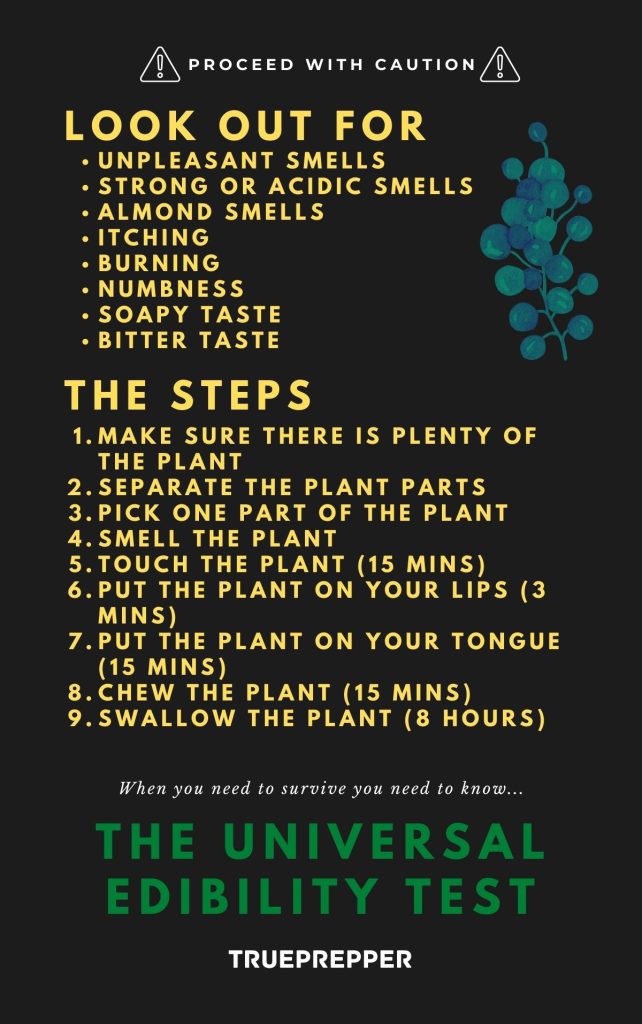
This article provides an updated guide on the Universal Edibility Test. We continuously update this information as we gain more experience and knowledge about foraging, as well as discover new methods for testing edibility.
In survival situations, it may become necessary to test the edibility of plants. However, randomly consuming any greenery you come across is not advisable, and you may not have the time to learn about all the local flora. The Universal Edibility Test exists to help you determine which plants, or parts of plants, are safe to eat. While the process may seem time-consuming, it is crucial for your safety when trying new plants.
Understanding the Universal Edibility Test
The Universal Edibility Test is a series of steps designed to determine whether an unknown plant is toxic or edible in a life-or-death situation. It is recommended to use this test only when other food resources are unavailable or in emergency situations.
Step 1: Gather Plenty of the Plant
Before initiating the Universal Edibility Test, ensure that you have an ample supply of the plant you wish to test. This test is thorough and time-consuming, so it is essential to have enough plant material to perform each step.
Step 2: Separate the Parts
Divide the plant into separate piles, separating the flowers, buds, leaves, stems, seeds, and roots. It is essential to test each part of the plant individually, as certain components may be toxic while others are edible. For example, rhubarb stalks are edible, but the leaves are toxic. Additionally, ensure that the plant is in good condition, without any signs of rotting or insect infestation.
Step 3: Select One Part
Choose the part of the plant that is most abundant, as testing this portion will yield the best results for your time investment.
Step 4: Smell the Plant
If the plant emits an unpleasant odor, avoid consuming that particular part of the plant. Pay attention to strong or acidic smells, as they may indicate toxicity. A scent resembling almonds should be avoided, as it can indicate the presence of a toxic compound.
Step 5: Touch the Plant
Gently touch a piece of the plant to your wrist and leave it there for 15 minutes. If you experience itching, burning, or numbness, do not consume that part of the plant. Wait for eight hours before proceeding to the next step, observing your skin for the development of rashes or any other adverse reactions. Do not consume any part of the plant during this waiting period.
Step 6: Apply the Plant to Your Lips
For this step, you can cook the plant pieces as you would normally prepare them for consumption. Cooking is preferred as some plants are toxic when raw but safe to eat when cooked. After cooking, touch a portion of the plant to your lips and observe for any itching, burning, or numbness within the next three minutes. If you experience any of these symptoms, do not consume that part of the plant.
Step 7: Place the Plant on Your Tongue
Take a small portion of the plant and place it on your tongue, holding it there for 15 minutes.
Step 8: Chew the Plant
Chew the plant and keep it in your mouth for 15 minutes without swallowing. If the taste is soapy or bitter, spit it out, as this indicates inedibility.
Step 9: Swallow the Plant
Swallow the plant and wait for eight hours. If no adverse reactions occur during this period, prepare at least ¼ cup of the tested plant part and consume it. If you experience no negative effects after another eight hours, that part of the plant is deemed edible. Repeat this entire process for all parts of the plant, as the entire plant or only specific portions may be edible.
Universal Edibility Test Printable PDF
If you would like to have a printable PDF of the Universal Edibility Test for reference purposes, we have you covered. You can download a black and white PDF designed for standard 8.5″ x 11″ printing by opening the link in a new tab. From there, you can print it or save it to your computer:
Continue to explore, stay prepared, and prioritize your safety.
It's worth noting that the Universal Edibility Test may sometimes lead to the mistaken belief that edible plants are inedible. For example, stinging nettles are edible when cooked but can cause a skin reaction. Similarly, acorns and water lilies are extremely bitter unless boiled, which could lead to the false conclusion that they are inedible. While relying on a guide to learn about local plants may be more straightforward, understanding the procedure for testing a plant's edibility is always valuable knowledge to possess.
Here are some other guides our readers have found helpful:
- Best Foraging Bag for Mushroom Gathering
- Finding Food in the Desert: Hunt, Forage, and Survive
- Survival Food List | Pantry Stockpile Plan and Checklist
The post Universal Edibility Test | How to Test if Any Plant is Edible appeared first on TruePrepper.
—————————————————————————————————————————————————————————————–
By: Rusty Collins
Title: How to Determine if Any Plant is Edible: The Universal Edibility Test
Sourced From: www.trueprepper.com/universal-edibility-test/
Published Date: Tue, 30 Jan 2024 11:57:30 +0000

